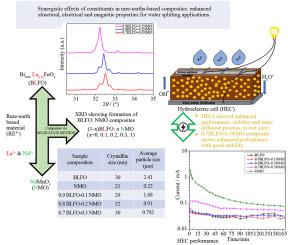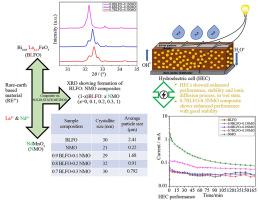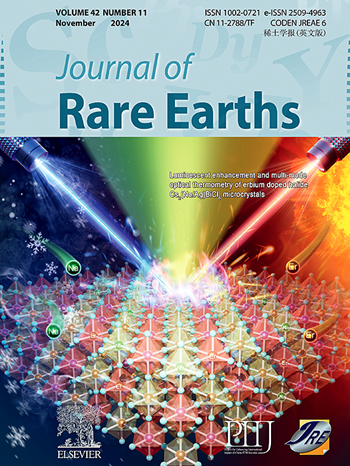Synergistic effects of constituents in rare earth-based composites: Enhanced structural, electrical and magnetic properties for water splitting applications
IF 7.2
1区 化学
Q1 CHEMISTRY, APPLIED
引用次数: 0
Abstract
Rare earth-based Bi0.85La0.15FeO3 (BLFO) and NdMnO3 (NMO) particles were synthesised using the solid-state route, and their roles affecting structural, electrical, magnetic properties along with hydroelectric application in different concentrations i.e., (1–x)BLFO:xNMO (where x = 0, 0.10, 0.20, 0.30 and 1.0) ceramics composites were investigated. X-ray diffraction analyses confirm the pure-phase formation of BLFO:NMO composites, featuring micrometer-scale crystallite sizes. Fourier transform infrared (FT-IR) spectra of BLFO:NMO composites reveal peak shifts with rising NMO content, indicating composite formation. These composites exhibit robust Maxwell–Wagner polarization and a pronounced composition-dependent behavior. The addition of NMO to BLFO results in a rise in dielectric permittivity at lower frequencies, confirming relaxor behavior and indicating success in achieving the transition temperature. Impedance spectroscopy facilitates a clearer understanding of how charge carriers contribute to these composites and the impact of grain/grain boundaries. The saturation magnetization maximum value (i.e., 0.807 emu/g) was attained in 0.7BLFO-0.3NMO. The coercivity decreases with the addition of NMO in BLFO. The results suggest the composite's enhanced suitability for microelectronics and hydropower cells, showing improved hydroelectric cell performance with increased NMO in BLFO, highlighting a notable ion diffusion mechanism.


稀土基复合材料中各种成分的协同效应:增强水分离应用的结构、电和磁特性
采用固态路线合成了稀土基 Bi0.85La0.15FeO3 (BLFO) 和 NdMnO3 (NMO) 颗粒,并研究了它们在不同浓度的 (1-x)BLFO:xNMO (其中 x = 0、0.10、0.20、0.30 和 1.0)陶瓷复合材料中对结构、电学、磁学特性以及水电应用的影响。X 射线衍射分析证实 BLFO:NMO 复合材料是纯相形成的,具有微米级的结晶尺寸。BLFO:NMO 复合材料的傅立叶变换红外光谱(FT-IR)显示,随着 NMO 含量的增加,峰值会发生移动,这表明复合材料已经形成。这些复合材料表现出强大的麦克斯韦尔-瓦格纳极化和明显的成分依赖行为。在 BLFO 中添加 NMO 会导致介电常数在较低频率下上升,从而证实了弛豫器行为,并表明成功达到了转变温度。阻抗光谱有助于更清楚地了解电荷载流子对这些复合材料的贡献以及晶粒/晶粒边界的影响。0.7BLFO-0.3NMO 达到了饱和磁化最大值(即 0.807 emu/g)。矫顽力随着 BLFO 中 NMO 的添加而降低。结果表明,随着 BLFO 中 NMO 含量的增加,复合材料在微电子学和水力发电电池中的适用性增强,水力发电电池的性能也得到改善,突出了显著的离子扩散机制。
本文章由计算机程序翻译,如有差异,请以英文原文为准。
求助全文
约1分钟内获得全文
求助全文
来源期刊

Journal of Rare Earths
化学-应用化学
CiteScore
8.70
自引率
14.30%
发文量
374
审稿时长
1.7 months
期刊介绍:
The Journal of Rare Earths reports studies on the 17 rare earth elements. It is a unique English-language learned journal that publishes works on various aspects of basic theory and applied science in the field of rare earths (RE). The journal accepts original high-quality original research papers and review articles with inventive content, and complete experimental data. It represents high academic standards and new progress in the RE field. Due to the advantage of abundant RE resources of China, the research on RE develops very actively, and papers on the latest progress in this field emerge every year. It is not only an important resource in which technicians publish and obtain their latest research results on RE, but also an important way of reflecting the updated progress in RE research field.
The Journal of Rare Earths covers all research and application of RE rare earths including spectroscopy, luminescence and phosphors, rare earth catalysis, magnetism and magnetic materials, advanced rare earth materials, RE chemistry & hydrometallurgy, RE metallography & pyrometallurgy, RE new materials, RE solid state physics & solid state chemistry, rare earth applications, RE analysis & test, RE geology & ore dressing, etc.
 求助内容:
求助内容: 应助结果提醒方式:
应助结果提醒方式:


